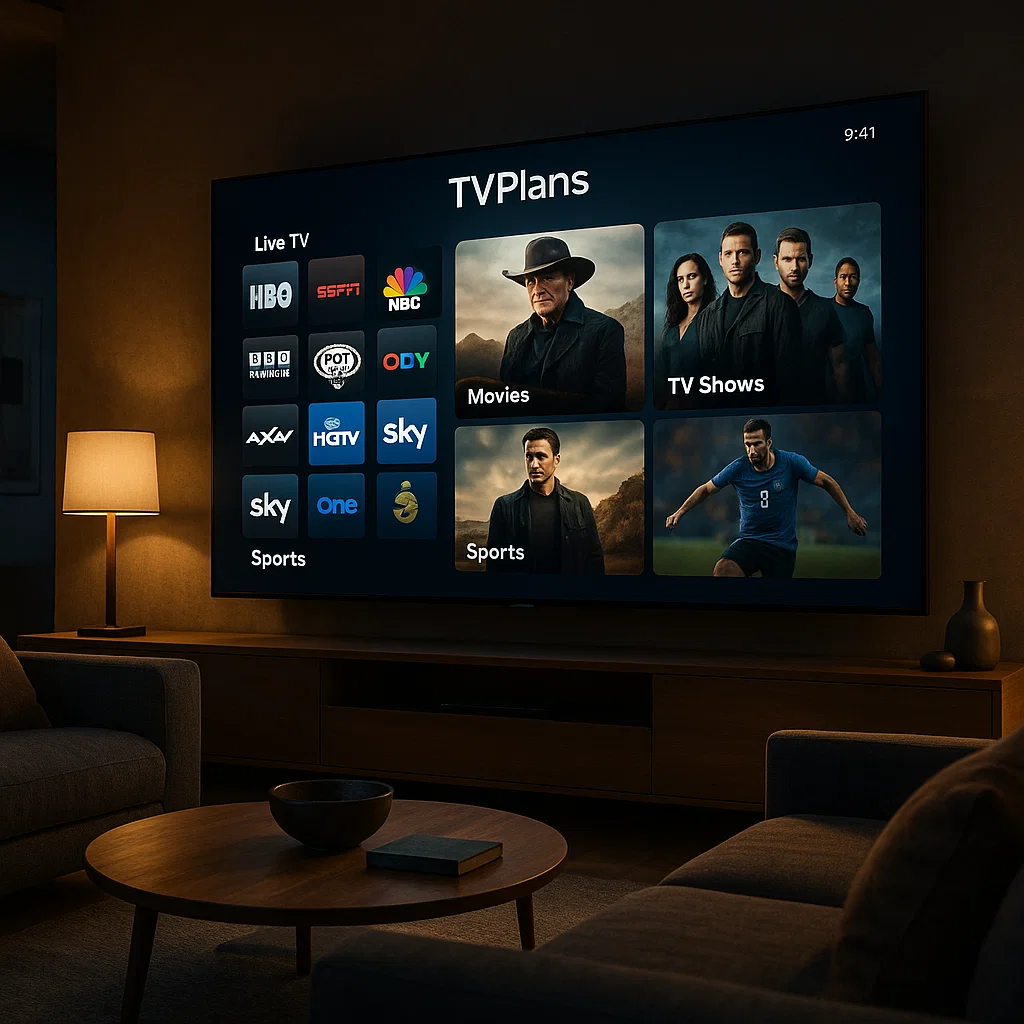

The television landscape has undergone a remarkable transformation over the past decade. Gone are the days when viewers were confined to traditional cable subscriptions with limited channel options and rigid scheduling. Today, Internet Protocol Television (IPTV) has emerged as a revolutionary alternative, offering unprecedented flexibility and content variety. Among the numerous IPTV providers competing for attention in this crowded marketplace, TVPlans IPTV has carved out a distinctive position as a service worth exploring for cord-cutters and streaming enthusiasts alike.

Before diving into the specifics of any particular service, it’s essential to grasp what IPTV actually means and why it represents such a significant shift in how we consume television content. Unlike traditional broadcasting methods that rely on satellite signals or cable infrastructure, IPTV delivers television programming through internet protocol networks. This fundamental difference unlocks possibilities that simply weren’t feasible with older technologies.
When you stream a show through an IPTV service, the content travels through the same internet connection you use for browsing websites or checking email. This delivery method provides several inherent advantages. For starters, it eliminates the need for specialized equipment like satellite dishes or extensive cable wiring throughout your property. Instead, you can access your entertainment on virtually any device with an internet connection and compatible software.
The economic implications are equally compelling. Traditional cable companies maintained expensive physical infrastructure that required constant maintenance and updates. These costs were inevitably passed down to consumers through monthly bills that seemed to climb higher each year. IPTV providers operate with lower overhead expenses, which often translates into more competitive pricing structures for subscribers.
Contemporary television viewers face a paradox of choice. The streaming market has become increasingly fragmented, with major content producers launching their own platforms and withdrawing their shows from competitors. A household that wants comprehensive access to popular programming might need subscriptions to half a dozen different services, quickly making the total monthly expense rival or exceed what traditional cable once cost.
This fragmentation has created genuine frustration among consumers who simply want convenient access to their favorite content without juggling multiple apps, remembering different passwords, and managing various billing cycles. The appeal of a unified solution that aggregates content from multiple sources into a single, streamlined interface has never been stronger.
Additionally, geographic restrictions continue to plague the streaming industry. Many services limit their content libraries based on the viewer’s location due to licensing agreements and regional restrictions. Someone traveling abroad might find themselves unable to access shows they regularly watch at home, despite maintaining an active subscription. These limitations feel increasingly outdated in our interconnected global society.
Not all IPTV providers deliver the same experience or value proposition. The market includes everything from dubious operations of questionable legality to professional services that invest heavily in infrastructure and customer support. Understanding the characteristics that distinguish quality providers helps consumers make informed decisions.
Reliability stands as perhaps the most crucial factor. An IPTV service that frequently buffers, experiences outages, or delivers inconsistent video quality quickly becomes more frustrating than the problems it was meant to solve. Top-tier providers invest in robust server infrastructure, content delivery networks, and redundancy systems to ensure smooth streaming experiences even during peak usage times.
Content variety matters tremendously as well. While some IPTV services focus narrowly on specific niches like sports or international programming, others aim to provide comprehensive offerings that cover entertainment, news, sports, movies, documentaries, and specialty channels. The breadth of available content directly impacts whether a service can truly replace traditional cable for a diverse household with varying interests.
User experience cannot be overlooked. The interface through which viewers navigate and discover content significantly affects daily satisfaction with a service. Intuitive menus, effective search functionality, personalized recommendations, and seamless device compatibility all contribute to an enjoyable viewing experience. Services that neglect these aspects often struggle to retain subscribers regardless of their content libraries.
Customer support represents another differentiating factor. Technical issues inevitably arise, whether related to connectivity problems, billing questions, or device compatibility. Providers that offer responsive, knowledgeable support through multiple channels demonstrate their commitment to customer satisfaction. In contrast, services that provide minimal or slow support leave users feeling abandoned when problems occur.

When examining tvplans iptv as a service option, several aspects warrant consideration. Like other premium IPTV providers, the platform aims to deliver comprehensive streaming solutions that address the pain points associated with both traditional cable and fragmented streaming services.
The channel selection typically encompasses a wide spectrum of content categories. Sports enthusiasts can find dedicated channels covering everything from major professional leagues to niche sporting events. Movie buffers gain access to channels that showcase recent releases alongside classic films spanning various genres and eras. News junkies can stay informed through multiple domestic and international news networks providing diverse perspectives on current events.
Entertainment programming forms a substantial portion of any comprehensive TVPlans IPTV service. This includes popular cable networks known for their original series, reality shows, cooking competitions, home improvement programs, and countless other formats that have become staples of modern television culture. Family-friendly content ensures that households with children have age-appropriate options readily available.
International programming deserves special mention, as it represents an area where IPTV services often excel compared to traditional cable packages. Viewers can access channels from various countries and regions, making these services particularly valuable for immigrant communities wanting to maintain connections with their cultures of origin. Language diversity transforms the television experience into something that serves truly global audiences.
Successfully implementing an IPTV solution requires attention to technical requirements that differ somewhat from traditional television or even standard streaming services. Your internet connection serves as the foundation for everything else, making its quality absolutely paramount.
Bandwidth requirements vary based on the video quality you desire. Standard definition content can stream adequately over connections delivering around 5 Mbps, but this represents the bare minimum. High definition programming demands considerably more bandwidth, typically requiring at least 10-15 Mbps for smooth playback without buffering. Those seeking premium 4K ultra-high-definition experiences should ensure their connections can deliver 25 Mbps or more consistently.
Connection stability matters as much as raw speed. An internet connection that fluctuates wildly or experiences frequent dropouts will produce frustrating viewing experiences regardless of its theoretical maximum speed. Wired ethernet connections generally provide superior stability compared to WiFi, making them preferable for primary viewing devices when practical. If WiFi is necessary, positioning your router strategically and minimizing interference from other devices and networks improves results.
Device compatibility extends the value of an IPTV subscription across your entire household. Most quality services support popular platforms including Android and iOS mobile devices, Amazon Fire TV products, Android TV boxes, smart televisions, and computer operating systems like Windows and MacOS. Some providers also offer compatibility with less common platforms, expanding access options for users with diverse device ecosystems.
Application quality significantly impacts the user experience. A well-designed IPTV application loads quickly, responds smoothly to navigation inputs, remembers user preferences, and provides intuitive controls for common functions like changing channels, adjusting volume, or accessing the program guide. Poorly optimized applications can make even excellent content feel frustrating to access.
The IPTV industry exists within a complex legal landscape that consumers should understand before committing to any service. Not all TVPlans IPTV providers operate within legal frameworks, and using unauthorized services can expose subscribers to various risks beyond just potential legal consequences.
Legitimate IPTV services obtain proper licensing agreements for the content they distribute. These agreements ensure that content creators, studios, networks, and rights holders receive appropriate compensation for their work. While legally-operating services may cost more than dubious alternatives, this price difference reflects the proper licensing expenses that legitimate businesses incur.
Pirate TVPlans IPTV operations, conversely, distribute content without authorization from rights holders. These services often advertise suspiciously low prices and impossibly comprehensive channel lineups. While they might seem attractive initially, they carry significant downsides. Beyond the ethical issues of consuming content without compensating creators, these services frequently disappear suddenly when authorities take action, leaving subscribers without recourse.
Security and privacy concerns accompany unauthorized IPTV services as well. Operators running illegal streaming operations have little incentive to protect user data or implement robust security measures. Subscribers might unknowingly expose their personal information, payment details, or viewing habits to bad actors. Some illegal IPTV applications have even been discovered containing malware designed to compromise user devices.
Smart consumers research providers before subscribing, looking for signs of legitimacy like transparent company information, professional websites, established customer support channels, and realistic pricing that reflects actual content licensing costs. If an offering seems too good to be true, it very likely is.
Once you’ve selected an appropriate IPTV service, several strategies can help you extract maximum value from your subscription. Optimizing your setup and understanding the available features transforms a basic streaming service into a comprehensive entertainment solution.
Explore the electronic program guide thoroughly. Modern IPTV services typically include detailed program guides showing what’s currently airing and what’s scheduled for hours or days ahead. These guides often allow you to set reminders for upcoming shows, record programs for later viewing, or instantly tune to something that catches your interest. Spending time familiarizing yourself with the guide’s features pays dividends in convenience.
Take advantage of multi-device streaming if your subscription permits it. Many IPTV services allow simultaneous streams on multiple devices, enabling different family members to watch different content concurrently. This feature effectively provides personalized entertainment experiences for each household member without requiring separate subscriptions.
Investigate catch-up and video-on-demand features if available. Some IPTV services archive recently-aired programming, allowing you to watch shows from the past several days even if you missed their original broadcast. This functionality bridges the gap between live television and pure on-demand streaming, offering flexibility that traditional cable can’t match.
Consider using parental controls to create a safe viewing environment for children. Quality IPTV services implement robust parental control systems that allow parents to restrict access to age-inappropriate content, set viewing time limits, and create separate profiles with customized content selections for younger family members.
The trajectory of the television industry clearly points toward continued growth of internet-based delivery methods. Traditional cable and satellite providers have watched their subscriber numbers decline steadily as consumers migrate toward more flexible, affordable alternatives. This trend shows no signs of reversing.
Technological advances continue improving the IPTV experience. Faster internet connections reaching more households globally expand the potential audience for these services. Enhanced compression technologies allow higher-quality video to stream using less bandwidth. Improved recommendation algorithms help viewers discover content matching their interests from increasingly vast libraries.
The integration of IPTV with other smart home technologies opens intriguing possibilities. Voice-activated controls, integration with home automation systems, and seamless switching between devices create increasingly frictionless entertainment experiences. The television might become just one component of comprehensive digital ecosystems that adapt to user preferences and routines.
Content personalization will likely grow more sophisticated. Rather than simply offering vast catalogs, future IPTV services might curate individualized experiences based on viewing history, time of day, current events, and even mood indicators. Machine learning could identify patterns in your viewing habits and proactively suggest content you’ll enjoy before you even think to search for it.
Choosing an IPTV provider represents a significant decision that affects your daily entertainment experiences and monthly budget. A systematic approach to evaluation helps ensure you select a service aligned with your specific needs and preferences.
Start by honestly assessing what content matters most to your household. Do you primarily watch sports, or does your family have diverse interests spanning movies, documentaries, and international programming? Does anyone in your home require specific niche channels? Understanding your actual viewing patterns prevents you from paying for content you’ll never watch.
Evaluate your technical infrastructure realistically. Test your internet speed during typical viewing hours when network congestion peaks. Consider whether your existing devices can run IPTV applications smoothly or whether you’ll need to invest in new hardware. Factor these potential additional costs into your decision-making process.
Research customer experiences with providers you’re considering. Online reviews and user forums provide valuable insights into real-world performance, customer service quality, and potential issues that official marketing materials won’t mention. Look for patterns in feedback rather than focusing on isolated complaints, as every service will have some dissatisfied customers.
Take advantage of trial periods when available. Many reputable IPTV services offer short trial subscriptions or money-back guarantees that allow you to test the service risk-free. These trials provide invaluable hands-on experience that no amount of research can replicate. Use trial periods to verify that promised features work as advertised and that content quality meets your standards.
Compare pricing structures carefully, looking beyond just monthly subscription costs. Consider activation fees, equipment rental charges if applicable, and any additional expenses for premium features or extra simultaneous streams. Calculate the total cost of ownership over a year to make accurate comparisons between providers.
The television industry will continue evolving rapidly as new technologies emerge and consumer preferences shift. Services like tvplans iptv represent the current state of this evolution, offering alternatives to traditional cable that align with how modern audiences want to consume content. By understanding the IPTV landscape, evaluating options systematically, and choosing services that match your specific needs, you can craft an entertainment solution that delivers both value and satisfaction. The future of television is streaming, and informed consumers stand positioned to enjoy its benefits fully.Réessaye